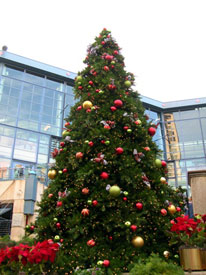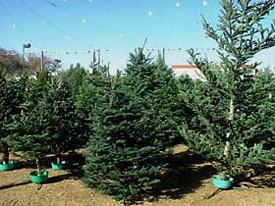
"Real versus artificial" is always a hot debate, regardless of the object in question. Over the next month or so, the debate will be applied to Christmas trees. As an outdoorsman with scores of houseplants, I prefer real trees, but artificial ones have their place. Another option is a living Christmas tree that's either potted or balled and burlapped. All of them look beautiful and shelter presents. Your decision depends on your preferences.
Makers of artificial trees claim their products are green because they are reusable for decades. Conserving and reusing materials is definitely environmentally sound. But a closer look exposes some ugly truths. Artificial plastic trees are made from oil. The process of making the PVC (polyvinyl chloride) needles emits volatile gases and pollutants. Most artificials are made in China and shipped to America, requiring vast amounts of fuel. Plus, as we found out with toys earlier this year, not all Chinese manufacturers meet our standards for quality control. Lead dust has been found on artificial Christmas trees.
If you suspect your tree contains lead, Richard Maas of the University of North Carolina in Asheville, suggests keeping your kids away from the tree. Good luck with that. To find out if your tree has lead, read the label, call the manufacturer, or contact the National Lead Information Center.
In defense of artificials, many of them won't have toxic chemicals. In addition, for convenience and value, artificial Christmas trees can't be beat. As a kid, I remember going to the attic (an adventure in itself) every December and taking out the boxes with the tree and ornaments. My sister and I loved to fit the sturdy branches into the stem. It required no watering, no pruning, no straightening, or any maintenance at all, just loads of decorations and presents. For people with allergies, an artificial tree may be the only option. Apartment and condo dwellers often choose an artificial tree because it is easier and less messy to transport in an elevator or up a stairwell.
Parents who want the convenience of an artificial tree might choose aluminum. Although more expensive than a PVC tree, aluminum is less toxic and is 100 percent recyclable. Aluminum trees and many plastic trees come in an array of colors that allow the artsy and eclectic to personalize their Christmas.

Christmas tree lots offer many types of trees in many shapes and sizes. (Photo by Cathy Cromell)
Gardeners often choose the greenest options and therefore are drawn towards real trees. But both have some claim to "green," though neither is totally environmentally friendly. Real trees are obviously alive and typically local. As they grow, they filter water and air, sequester carbon, prevent erosion, and produce oxygen. When the tree is cut for sale, it is immediately replaced with between one and three seedlings, according to the National Christmas Tree Association. This keeps the tree plantation in a constant state of green and growing. However, it is at the expense of native vegetation and biological diversity. Christmas tree plantations are often extensive monocultures that sometimes use pesticides, which can drift or leach into other areas.
Personally, I like my Christmas trees to be fresh and green, and here, too, there are many choices. The chart below lists some of the more common species and their qualities.
| Name | Color | Fragrance | Area Grown | Needles | Other |
| Balsam fir (Abies balsamea) |
Dark green | Highly aromatic | Northeast, shipped throughout north | Fair retention, soft | Flexible branches |
| Frasier fir (Abies fraseri) |
Dark to silvery green | Highly aromatic | Southeast, shipped throughout east | Good retention, soft | Voted best tree in several polls |
| Douglas fir (Pseudotsuga menziesii) |
Green to bluish green | Sweet | Northwest, shipped nationwide | Good retention, soft | Firm branches |
| Colorado blue spruce (Picea pungens) |
Silvery green to powdery blue | Faint | West, shipped throughout west and parts of east | Good retention, sharp | Often sold as living balled and burlapped |
| Scotch pine (Pinus sylvestris) |
Green | Faint | East, most common tree in US | Excellent retention, sharp | Firm branches |
| White Pine (Pinus strobus) |
Yellowish green to bluish green | Average | East, shipped thoughout east | Good retention, soft | Flexible branches |
| Leyland cypress (Cupressocyparis leylandii) |
Dark green | No scent | Southeast, sold locally, becoming more popular | Excellent retention, soft | No resin |
At the tree lot, make sure the tree is still green and moist. Sniff the needles for fragrance. Run a gloved hand along the branch to see if any needles easily detach. Finally, grab the tree by the trunk, lift it up a bit, and thump it down while holding onto it. If a lot of needles fall off, then the tree is drying out and will drop its needles on your living room floor. If the tree passes the freshness test and the lot manager has not kicked you out, then you have found your Christmas tree.
For those with a large landscape, consider buying a living tree and planting it after the holidays. Living trees are the greenest option of all and give you a reason to garden in the winter. This is not a choice for extremely cold climates, but it is perfect for the southeast and West Coast, where December and January are excellent times to plant trees. Almost any evergreen will do; junipers, cypresses, true cedars, pines, spruces, and cryptomeria are common options.
Make sure you have enough space for the full-grown tree before buying. Most commercial Christmas trees grow into big specimens. Large conifers need to be planted at least 30 feet from the house. For energy-saving benefits, plant on the north, west, or northwest side to screen against cold winter winds.
Consider the weight of the tree before buying. A 5- to 6-foot balled-and-burlapped tree can weigh 200 pounds or more. Container trees are usually lighter. A wheelbarrow, hand truck, dolly, or muscular husband is a must.
It can be tricky to use living trees for indoor winter decoration and also keep them alive for planting, but the rewards and memories last a lifetime. Follow these guidelines for ball-and-burlapped or potted trees:
Select a location and dig a hole before the ground freezes. In general, the hole should be about 18 inches deep and 36 inches wide. Heap the soil on a tarp or blanket and cover it. Use this soil to backfill the hole when planting. Buy a healthy looking tree with an intact rootball. Transport the tree carefully and handle the rootball gently. Cover the tree while transporting it to protect against desiccating winds. Once home, spray the needles with an antitranspirant such as Wilt-Pruf or Vapor-guard. Thoroughly soak the rootball and keep it moist. Store your tree in a shady spot outdoors or in an unheated garage. Mulch or cover the rootball with a blanket to prevent it from freezing. Bring the tree into your house close to Christmas and situate it far away from radiators, heat vents, or stoves. For best success, the tree needs to be inside for a minimal amount of time. Most growers recommend only 7 to 10 days. If your home is more than 70 degrees F, reduce the time to 5 days.
To fill the void, pre-decorate the Christmas tree area with garlands, bows, lights, and presents. The tree will be the finishing touch. Place it in a large tray, pan, or (for the rustic and woodsy) a wheelbarrow. Decorate the tree. Use cool (LED) lights to avoid damaging the needles. Check the rootball often and keep it moist. Right after Christmas, remove the decorations and take the tree outside. Planting is a family activity. If potted, remove the tree from the pot. Do not plant it too deeply. Keep the top of the rootball at the soil surface. Use a measuring tape to accurately measure depth. If the hole is too deep, add some soil before planting. Place the tree in the prepared hole. If balled and burlapped, cut away the burlap, being mindful of nails or staples that may have been used. Backfill just enough to steady the plant. Ask family members to step away from the tree on different sides to assess its angle. Once everyone agrees the tree is straight, backfill the hole to about halfway up the rootball. Water well, and after the soil settles, check again that the tree remains straight. Backfill to the original planting depth (the top of the rootball) with the remaining soil. Water thoroughly and mulch. Dedicate your new tree, then celebrate and warm up with some hot chocolate (mixed with Frangelico for the adults).
For traditionalists with plenty of time for maintenance, there is no substitute for real trees, living or cut. Their fragrance evokes happy memories of childhood and excitement. Also, having a real tree links us to all the peoples throughout history who have brought boughs inside to celebrate religious or celestial events. Thousands of years ago Egyptians brought in palms and hollies to enliven their homes in winter. Keeping this custom alive with our Christmas trees connects us through cultures and time. But whether you choose artificial or real, a knowledgeable decision is a good decision. Enjoy the holidays!